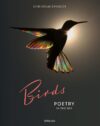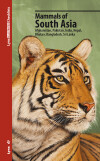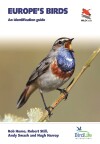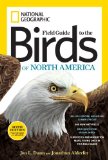 National Geographic Field Guide to the Birds of North America, Sixth Edition
National Geographic Field Guide to the Birds of North America, Sixth Edition
by Jon L. Dunn and Jonathan Alderfer
From the publisher:
For beginning and experienced birders alike, this is the most comprehensive bird guide available anywhere—now lavishly redone with a refreshed design; 300 new illustrations; 23 new-to-North America species; major updates in text with the latest taxonomy and science; range maps with all-new migration overlays; 40 subspecies maps (unique to this guide); fully annotated illustrations with field marks; and an ultra-convenient visual index on the inside flaps.
National Geographic’s flagship bird guide is essential for bird identification—authoritative, portable, sturdy and easier than ever to use—a birding bible for all bird lovers.
This new edition adds some undeniably cool features to the venerable NatGeo field guide, such as subspecies range maps, and separate colors on maps to indicate spring, autumn, and ‘both’ migration routes (first time I’ve seen that). But is it worth upgrading? Be on the lookout for a detailed list of changes and additions that will hopefully help answer that question. [Update: here is that list – National Geographic Field Guide to the Birds of North America, Sixth Edition – Initial Review]
The good folks at Princeton University Press are giving away a signed copy of The Crossley ID Guide, along with a couple of signed, poster-sized prints of plates. All you have to do to enter is “like” the new Princeton Birds & Natural History Facebook page before Halloween.
by James Lowen
A user-friendly guide that is a must for visitors to Antarctica.
Read the full review »
Looking through Amazon’s bargain bird books (look for the “Bargain Books” link on the left), I noticed a few great deals:
(look for the “Bargain Books” link on the left), I noticed a few great deals:
At these prices, all of these books are very much worth it. And there are plenty of others, too…
FYI: these links, as with all Amazon and iTunes links on this site, are affiliate links. That means a small portion of any purchases made through them will go toward supporting this site.
iPhone app for finding birds and birding spots.
Read the full review »
It is inevitable. We have field guide, listing, and bird finding apps on our phones. It’s only a matter of time before these devices will identify birds for us. That day may be sooner rather than later. A University of Wisconsin–Madison ornithologist is working on an app that will ID bird song – WeBIRD.
Tip of the hat to Princeton University Press Blog.
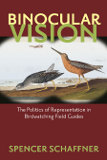
 The field guide is an indispensable tool of the birder. Birders study them, enjoy their art or photographs, and, of course, use them to identify birds. But how often do we really think about field guides and what we should expect from them? And have you ever considered the possibility that field guides may influence their users in matters other than identification? Spencer Schaffner has. In Binocular Vision
The field guide is an indispensable tool of the birder. Birders study them, enjoy their art or photographs, and, of course, use them to identify birds. But how often do we really think about field guides and what we should expect from them? And have you ever considered the possibility that field guides may influence their users in matters other than identification? Spencer Schaffner has. In Binocular Vision , Schaffner explores the broader implications, beyond that of ID, of bird representations in field guides.
, Schaffner explores the broader implications, beyond that of ID, of bird representations in field guides.
Schaffner starts with an examination of the first field guides from the late nineteenth century and contrasts their treatment of birds with modern guides. He goes on to scrutinize online and digital field guides, completing a look at the evolution of this genre from its beginnings unto today. But this book is more than a history of the field guide.
The author’s main contention is that “representations of birds and the environment in field-guide literature have much broader implications” than simply identification. Schaffner uses the term binocular vision to denote a way of “seeing and thinking about birds as detached from the physical, political, and ideological worlds that greatly affect them”. He argues that, with their focus on identification, field guides serve to foster this narrow view of nature.
I don’t agree with all of the author’s conclusions, but this book forced me to take a more critical look at field guides and what their role can and should be. And that made it very much worth reading.
Here’s the full review.
Binocular Vision: The Politics of Representation in Birdwatching Field Guides
by Spencer Schaffner
University of Massachusetts Press, 2011
$24.95
Disclosure: The item used to produce this review was a complementary review copy provided by the publisher.
Laura Erickson has posted a great overview/history of North American field guides on her blog.
It’s always a great day when Princeton University Press releases its catalog of upcoming natural history books. Or even just offers a preview, like today. Here are some books to look forward to in the first half of next year:
-
How to Be a Better Birder
Derek Lovitch
May, 2012
This unique illustrated handbook provides all the essential tools you need to become a better birder. Here Derek Lovitch offers a more effective way to go about identification—he calls it the “Whole Bird and More” approach—that will enable you to identify more birds, more quickly, more of the time.
He demonstrates how to use geography, an understanding of habitats, ecology, and even the weather to enrich your birding experience and find something out of the ordinary. Lovitch shows how to track nocturnal migrants using radar, collect data for bird conservation, discover exciting rarities, develop
patch lists—and much more. This is the ideal resource for intermediate and advanced birders. Whether you want to build a bigger list or simply learn more about birds, How to Be a Better Birder will take your birding skills to the next level.
-
Cotingas and Manakins
Guy M. Kirwan and Graeme Green
March, 2012
Cotingas and Manakins is the definitive work on these jewels of the Neotropics, covering more than 130 species. These range from some of the rarest and most enigmatic birds in the world to some of the best studied of all tropical species. Many are breathtakingly colorful and ornate while some are plain and difficult to see. This stunning volume features 34 color plates by Eustace Barnes, who has observed many of these species in the field, as well as distribution maps and approximately 400 color photographs that cover all but a tiny handful of species. Complete with detailed species accounts describing key identification features, Cotingas and Manakins is the
authoritative illustrated guide to these magnificent Neotropical birds.
-
A Field Guide to the Birds of New Zealand
Julian Fitter and Don Merton
January, 2012
New Zealand is commonly described as “the land of birds.” Now, there is an easy-to-use guide for all those interested in this country’s remarkable bird
population. A Field Guide to the Birds of New Zealand contains over 600 stunning photographs of the more than 350 bird species likely to be seen in this area of the world. Comprehensive and compact, the book includes full descriptions of all native species and regular visitors, distribution maps and measurements, key information on national parks, and useful information
on ongoing conservation efforts in the country. Filled with handy tips for nature enthusiasts wanting to make the most of their trip, this is the only bird guide that anyone exploring this region will need.
-
Birds of India, Pakistan, Nepal, Bangladesh, Bhutan, Sri Lanka, and the Maldives: second edition
Richard Grimmett, Carol Inskipp, and Tim Inskipp
March, 2012
The best field guide to the birds of the Indian subcontinent is now even better. Thoroughly revised, with 73 new plates and many others updated or repainted, the second edition of Birds of India now features all
maps and text opposite the plates for quicker and easier reference. Newly identified species have been added, the text has been extensively revised, and all the maps are new. Comprehensive and definitive, this is the indispensable guide for anyone birding in this part of the world.
-
Birds of Central Asia: Kazakhstan, Turkmenistan, Uzbekistan,
Kyrgyzstan, Tajikistan, Afghanistan
Raffael Ayé, Manuel Schweizer, and Tobias Roth
March, 2012
Central Asia—a vast and remote area of steppe, semi-desert, and mountains separating Europe from eastern Asia—is home to a diversity of birds. Birds of Central Asia is the first-ever field guide to the avian population for this fascinating part of the world. From ground jays, larks, and raptors, to warblers, nuthatches, and snowfinches, this comprehensive guide covers 627 species—including all residents, migrants, and vagrants—and 141 superb plates depict every species and many distinct plumages and races. The portable book contains important introductory sections on the land and its birds, and up-to-date color maps. The concise, authoritative text on facing pages
highlights key identification features, such as status, voice, and habitat. Birds of Central Asia is indispensable for anyone interested in the birds of this remarkable and little-known region.
-
Birds of Aruba, Curaçao, and Bonaire
Bart de Boer, Eric Newton, and Robin Restall
March, 2012
Located in the southern Caribbean off the coast of Venezuela, the islands of Aruba, Curaçao, and Bonaire are home to a colorful diversity of bird species. Birds of Aruba, Curaçao, and Bonaire is the first comprehensive field guide to the birds of the region and the ideal companion for identifying the islands’ remarkable avian population. The compact and portable book contains close to 1,000 superb color illustrations on 71 color plates and detailed descriptions of every species. Concise text on facing pages highlights key identification features, including voice, habitat,
behavior, and status. This field guide is essential for all birdwatchers and wildlife enthusiasts interested in this part of the world.
-
Birds of Melanesia: Bismarcks, Solomons, Vanuatu, and New Caledonia
Guy Dutson
March, 2012
Melanesia harbors an amazing range of endemic bird species and subspecies, many of which are poorly known. Birds of Melanesia is the first comprehensive field guide to all 501 species found in the Bismarck
Archipelago, Bougainville, the Solomons, Vanuatu, and New Caledonia. This beautifully illustrated guide features 86 color plates that depict almost every
species—including many endemic subspecies—and many of the plates are arranged by island group for easy reference. Detailed species accounts describe
key identification features and distribution, as well as key features for all subspecies. Distribution bars are also given for all species except extreme vagrants.
 National Geographic Field Guide to the Birds of North America, Sixth Edition
National Geographic Field Guide to the Birds of North America, Sixth Edition








